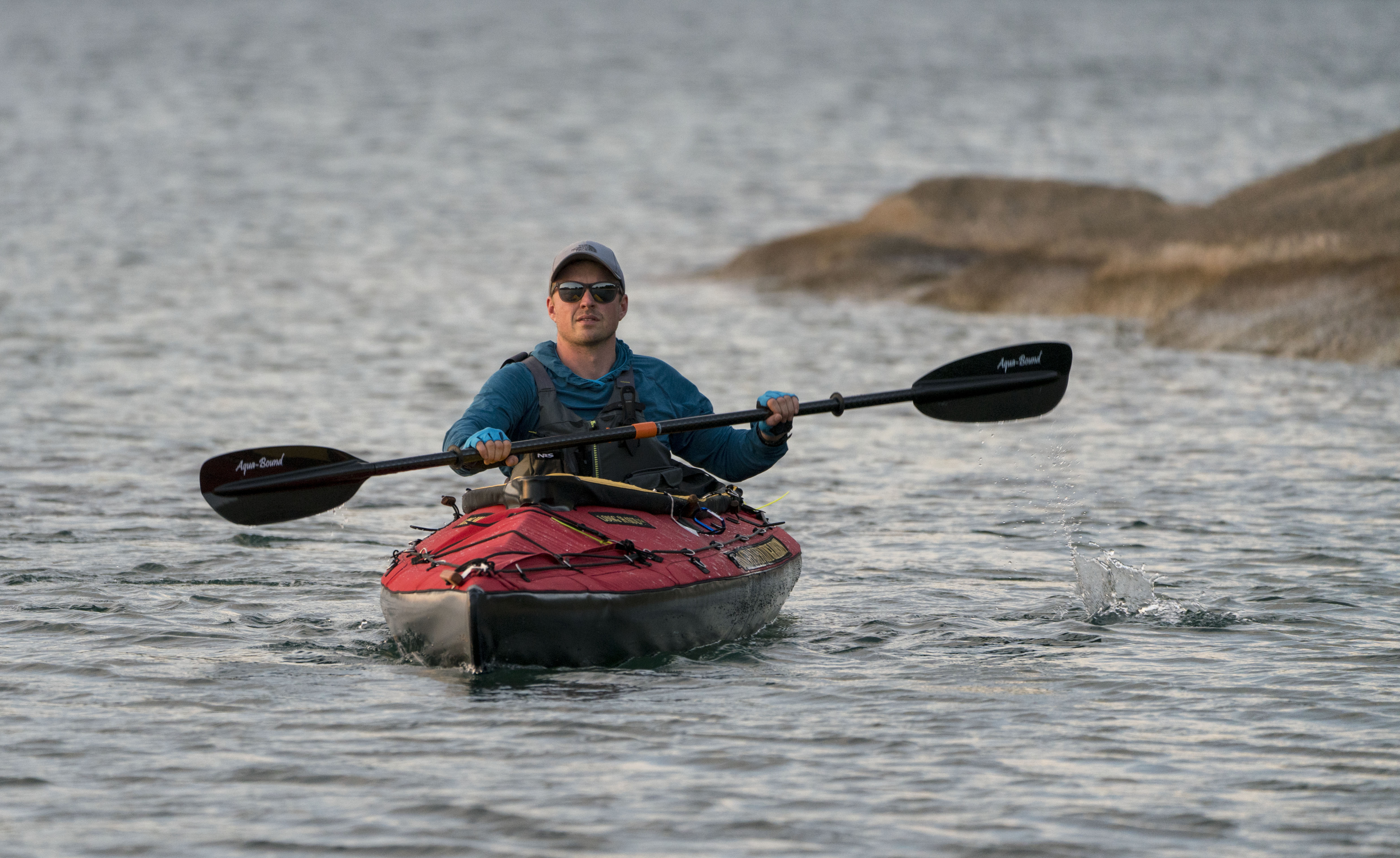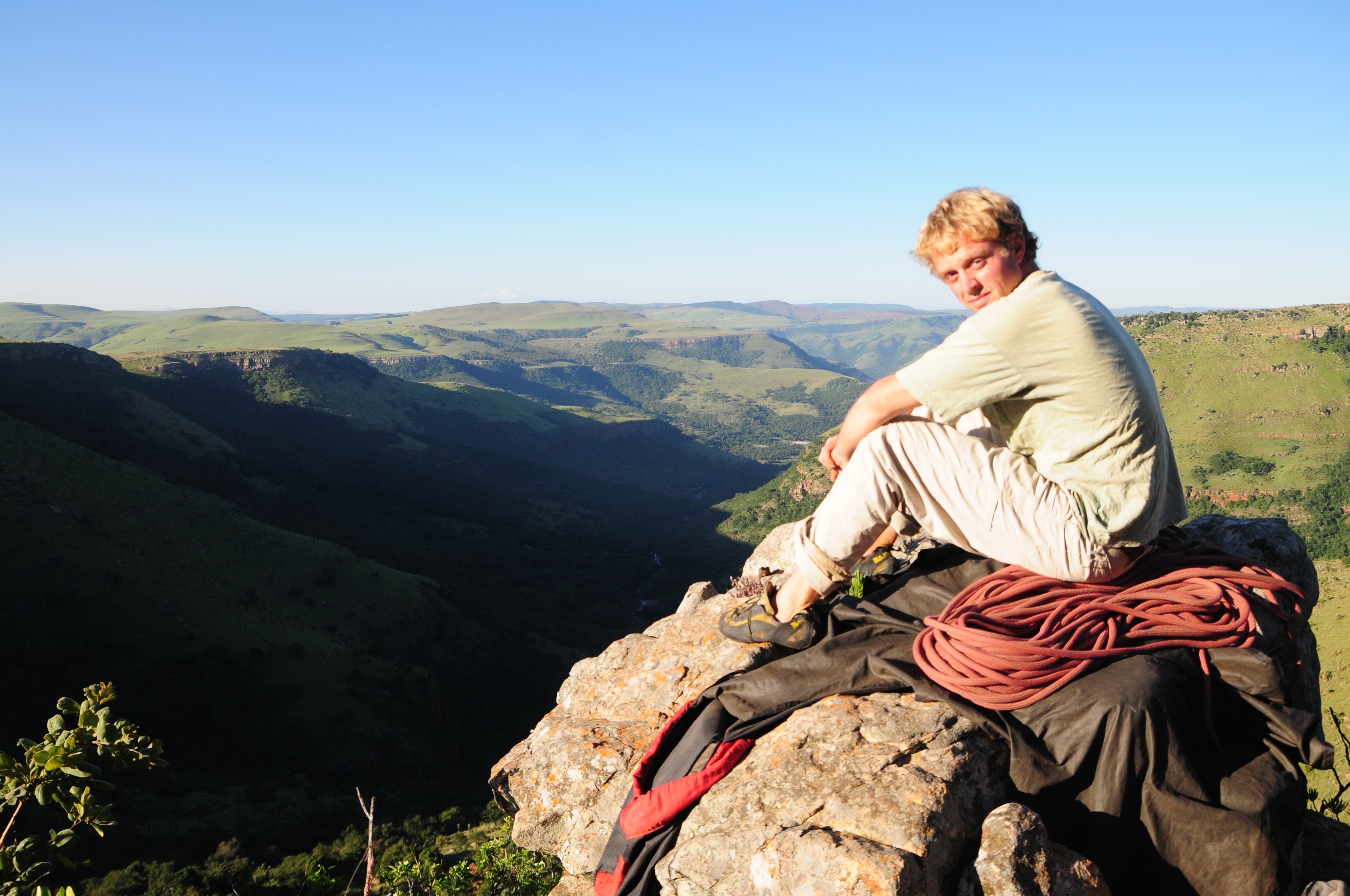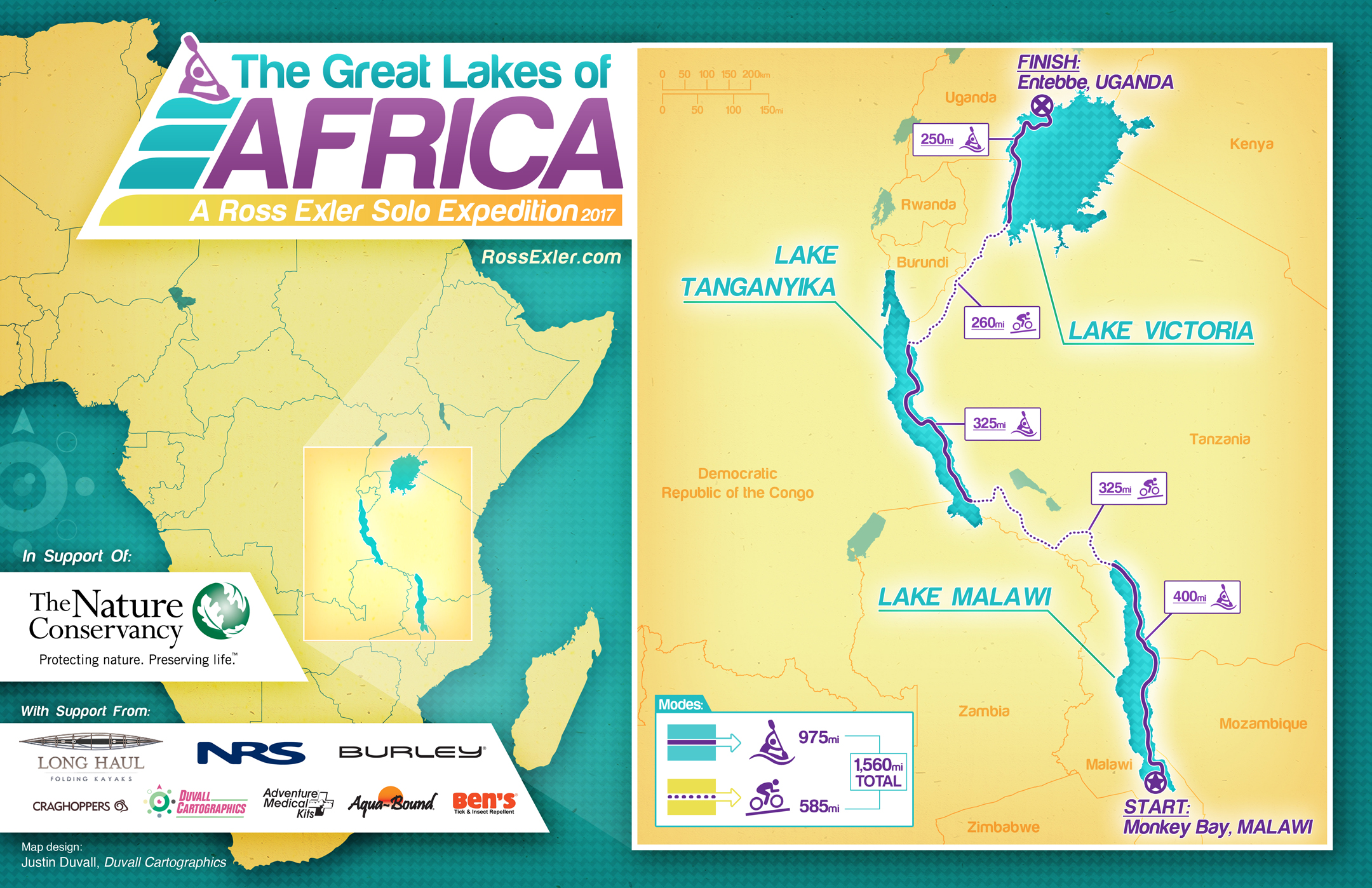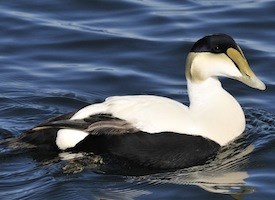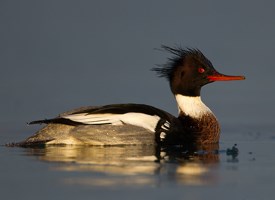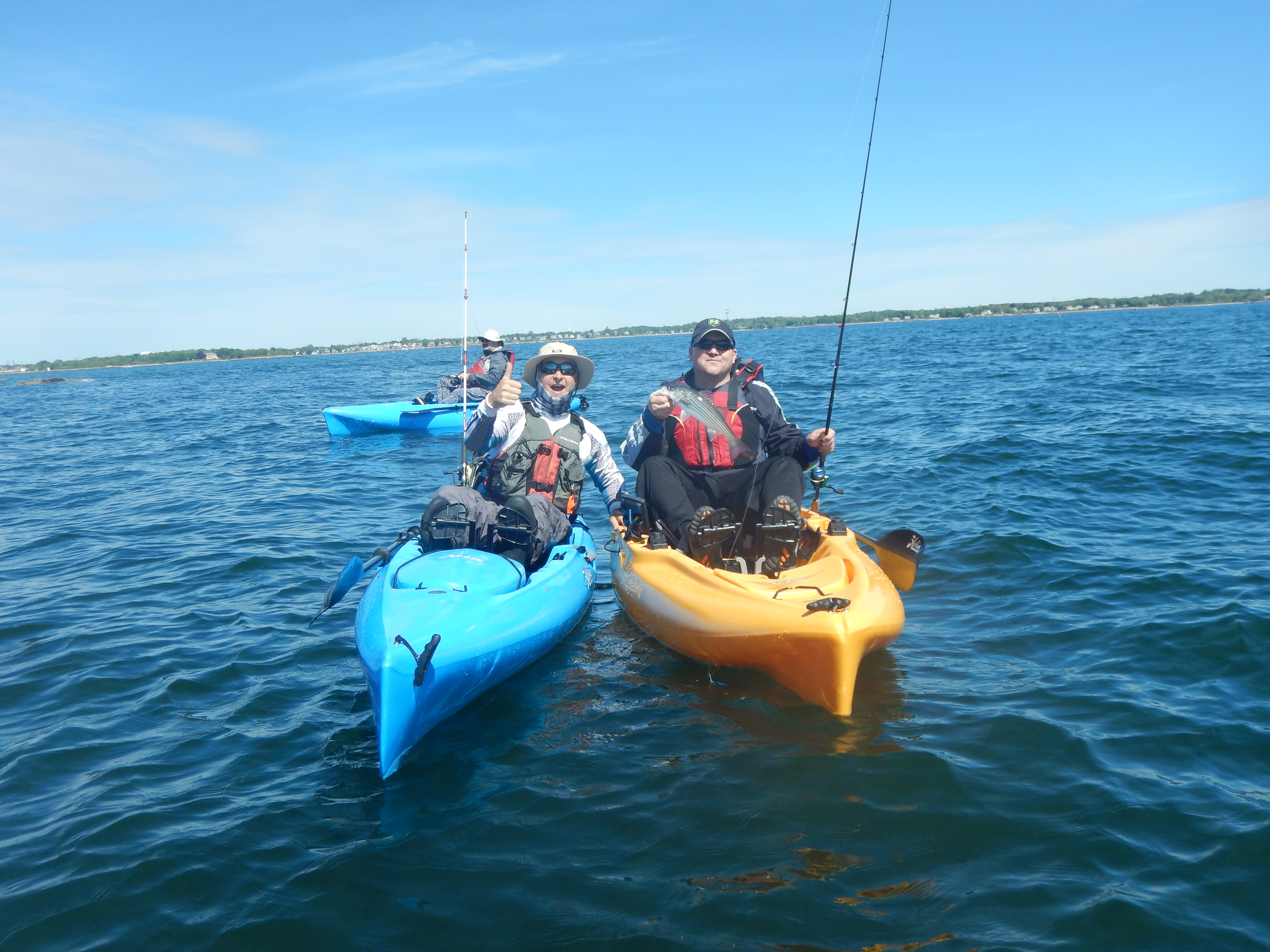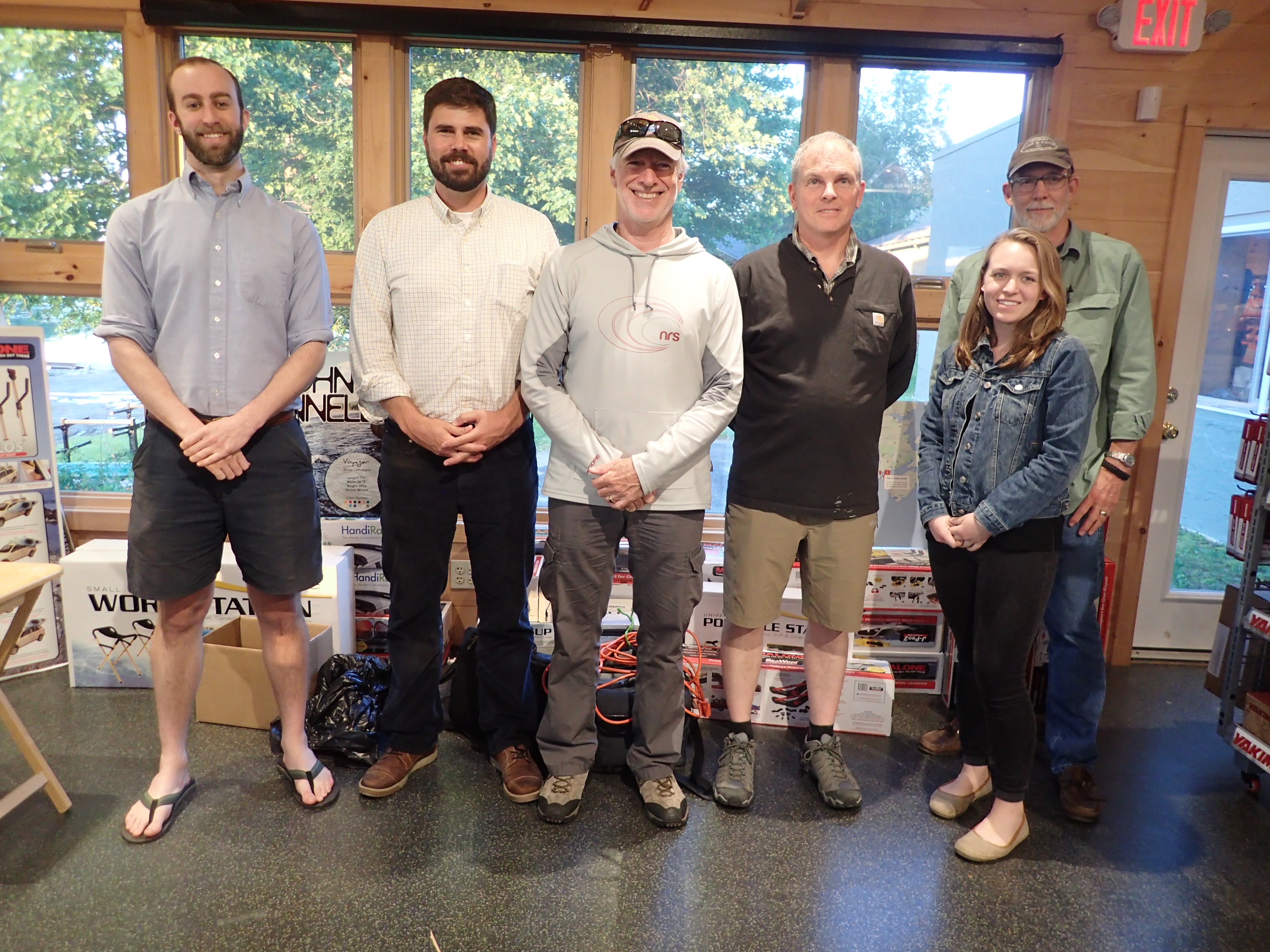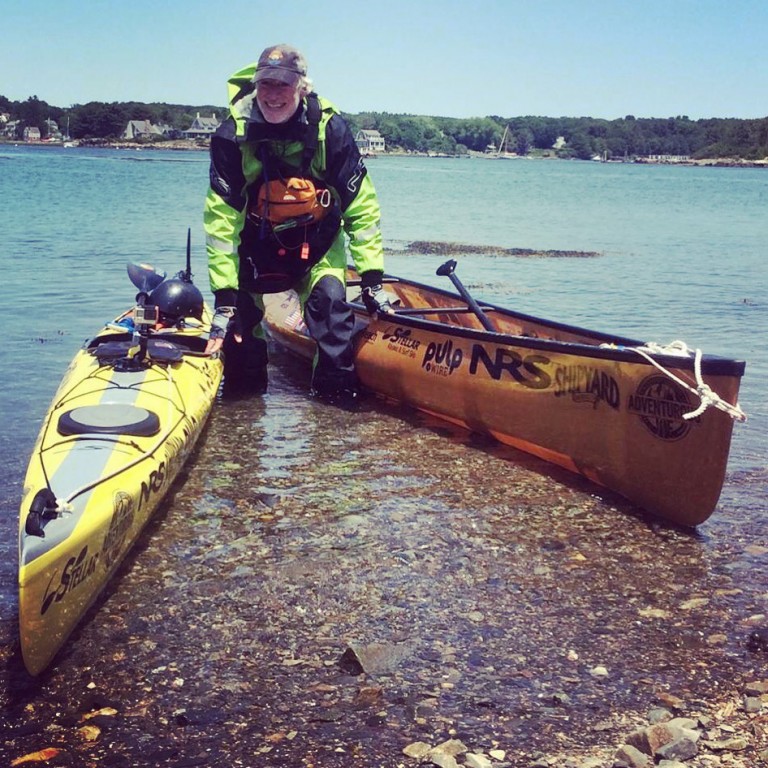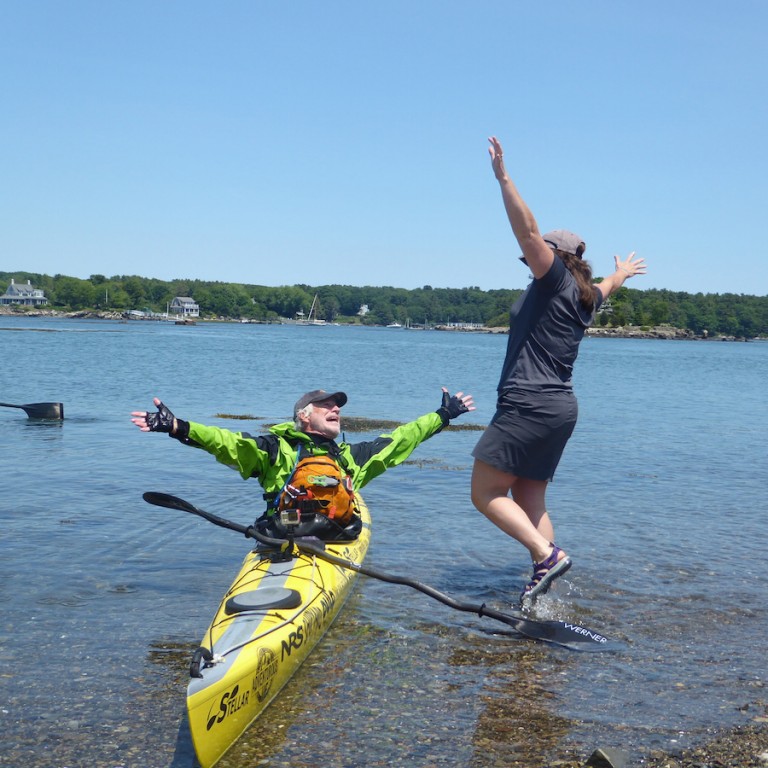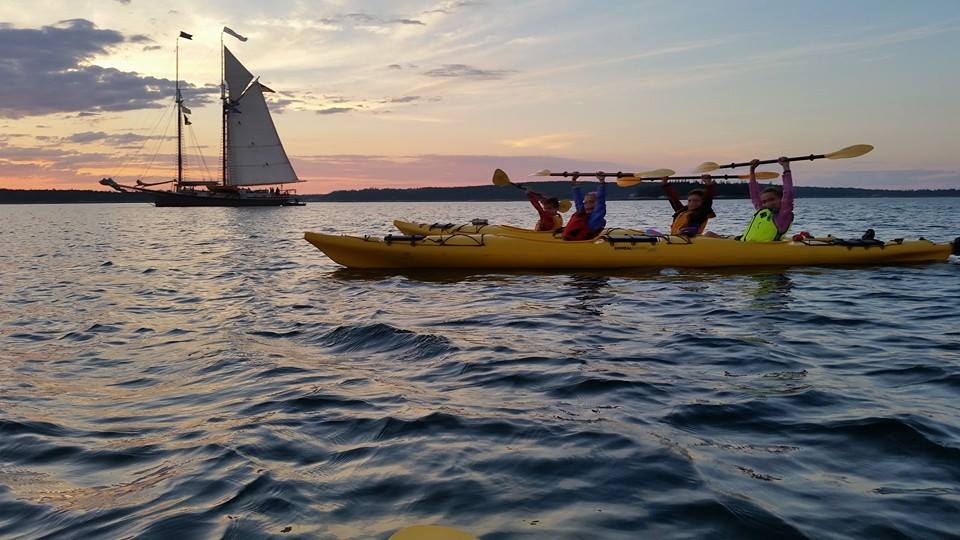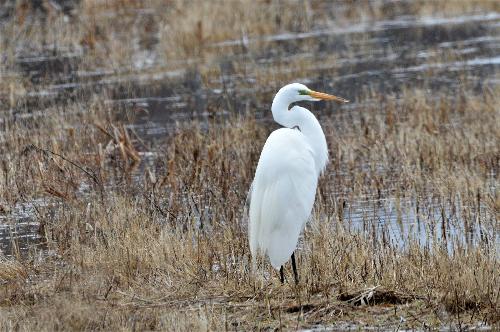
Tammy and David in the push to the finish. Photo copyright by and courtesy of Donna Lind.

The Nootka in Maine, 2002. It looks shorter because it’s angled away from the camera
Thursday night at home, Tammy says, “I really want to do the Essex Race this Saturday.”
“OK,” I respond. She runs the race every couple of years.
“Oh, and I’d like us to do it in a double.”
…
So here’s the story. First of all, the only time Tammy and I had raced a double kayak was the 1995 Blackburn Challenge in a fast Seda Tango loaned to us by Bob Hicks. Second, our own double, a large Necky Nootka more than 22 feet long (the boat I always used on our trips with the kids, with Lilly in the forward seat and Anton in the middle hatch. Fast, stable, and with plenty of room for gear and the occasional batch of lobsters bought directly from the lobster boats), has mostly sat on the racks for the past 12 years, since the kids moved into their own boats, quietly gaining water weight. The last time it was moved, I could have sworn it was tipping the scales at more than 100 pounds. Third, it was probably full of spiders and was pretty dirty after a winter on the racks under the oak trees, requiring its annual cleaning and polishing a little earlier than usual. Fourth, didn’t Ozzie Osborn of ERBA (Essex River Basin Adventures) just recently mention to me that his term for a double kayak was “divorce boat?”
Oh, and it also meant that I would have to find and install the Hullavator racks, because there was no way that we could lift the boat over our heads to get it on the car as we used to. We tried. Instant vertebral compression fractures.
We did figure out how to maneuver the boat up onto the car. (We had to bungee-unlock the Hullavator handles, then each grab an end of the kayak and swing it up, then release the handles so it would lock into the racks. Hope it works in reverse.) And on Saturday, May 20 at 07:15 hours, we rolled, bleary-eyed, into the ERR’s new venue at the Riversbend Restaurant in Essex. Fortunately, the change from funky, small-town marina to funky, small-town marina plus upscale restaurant meant that the access road, famous for its collection of potholes and small meteor craters, had been paved smoothly over.
Early as we were, the scene was already one of controlled (ish) madness, as craft ranging from SUPs through sea kayaks, surfskis, dories, sliding seats, up to multi-rower gigs looking as if they were just preparing to speed Captain Cook from the Greenwich docks out to the Endeavor, were carried on or behind autos from all over the East Coast. Since the parking lot triples as space for the restaurant, storage for many motorboats, and the headquarters of the Essex River Cruises, the crowd was well jammed in, looking for a way to drop their boats at the ramp. We were early enough to be able to find premium dockage for the Nootka next to the ramp in the marsh, and slide our car into a spot next to a line of cabin cruisers.
Then it was a matter of signing our lives away on the release form (“YOU MUST SIGN A WAIVER IN PERSON,” according to the website) and standing around waiting for the Captain’s Meeting at 08:30. The only grumbling in our crew was from my neglected tum, which had not had time for breakfast. Fortunately, one of the participants had brought in mass quantities of coffee, cream cheeses in various flavors, and bagels. Lovely!
(This act of charity underscores a critical aspect of the Cape Ann Rowing Club, which sponsors, organizes, and runs this race and July’s Blackburn Challenge. All aspects of the events, from planning and scheduling, through implementation to clean-up, are handled by volunteers. Nothing but praise for this great organization and its dedicated members.)
The Captain’s Meeting is where the course is gone over, heat starting times restated, and rules of the road laid out. The affair took place at the porch of the restaurant. The crowd was enlivened by a small group of officials, including the harbor master and some Coast Guard men packing heat. Over a bullhorn crackling with static directions blared out and were repeated to shouts of “Louder!” Then the only bit of disagreement occurred when the harbor master ordered that wearing of PFDs was required. The cries of, “NO!” and, “May 15th,” arose from all sides, but especially, it seems, from the SUP and surf ski paddlers. This made little sense to me, until I looked it up in Section 323 of the Code of Massachusetts Regulations:
“CMR Section 323-2.07(10): Any person aboard a canoe or kayak between January 1 to May 15 and between September 15 to December 31 shall wear at all times a Coast Guard approved personal flotation device of Type I, II, or III.”
Since it was after the 15th of May, the nays won. We dithered a bit on that one, trying to decide whether carrying our PFDs on deck, increasing windage, was worse than the binding that wearing them would cause. Since the wind was quite strong, and we would be heading into it for more than half of the 5.5 miles of the course, we decided to wear them.
Now boats began to take off as their heats were called. The organizer at the ramp was good at calling back vessels who tried to launch more than 15 minutes before their heat was called, a grim necessity in the narrow confines of the start. I began to feel the normal urges that precede a race, but was loath to go to the official porta-potties, situated a couple of hundred yards up the hill. These are traditionally decorated with long lines of desperate racers trying to get rid of all that coffee. Fortunately, Tammy had found one in the lower lot, hidden behind several large motor boats still on their winter racks. Whew!
Our next decision was where to put in. Our nice marsh launch site had succumbed to the steadily falling tide, and now we looked over a three-foot cliff. Not a great spot, but otherwise we would have to schlep our ocean liner over the boats that had jammed themselves in between us and the ramp. We decided to schlep, and, at last, we took to the water and approached the start.
The most important factor in a start is position, position, position, relative to the starting line. Also useful is some experience with your boat. As we came around the corner from the ramp, the north wind started blasting us full in the face, and the high prow of the Nootka, catching it like a sail, began to fall off, and we started moving backwards. (If you look at the photo of us heading towards the finish, you will see how my bulk lifts the bow right up. When I used to paddle with the kids in front, I would stick a couple of small boulders under the bow hatch to lessen this effect.) I pumped at the rudder pedals, trying to remember how they worked in reverse, and we soon found ourselves in an excellent position, if the race had been heading straight over the rapidly drying marsh. “Go!” rang out, and our competitors rushed off, followed belatedly by boat number 156.
The course first follows the meandering channel of the Essex River until it opens wide into Essex Bay towards the Cross Island archipelago (Cross, Dilly, and Corn). The dropping tide was with us as we headed out, but the advantage of the current was overwhelmed by wind. So, heads down and arms pumping, we started on our five-and-a-half-mile adventure.
It’s always a good idea before a race to do some training in the boat you plan to use. The question was, was 23 miles in an entirely different model two decades earlier sufficient for the day? Well, no. Because of our feeble start, we were dead last across the line. Still, we managed to maintain our position throughout the race!
In the confines of the river, the mass of our class seemed so very far ahead as we rounded a curve just in time to see them disappear around the next ahead. When we came out into Essex Bay, however, we could see that our position was not as desperate as we thought, and we traded leads with several doubles for the next mile or so. I pulled our rudder out to reduce drag, and we began to make up time.
Crossing the bay to Cross Island was a steady grind against the headwind over open water. Stroke timing in a double is critical, and it was my job as stern paddler to make sure that our strokes were as coordinated as possible, maximizing their effect. Stern paddler in a race in a headwind always gets a face-full of water, as the breeze flings the drip from the bow paddle directly into his face. The constant shower was actually not unpleasant, as it countered the effect of an extremely bright sun. The crust of dried salt on my sunglasses did make it hard to see, and I was startled when Tammy cried a warning to change course. Although it seems a straight push to Cross Island from the opening of the marsh into the bay, the falling tide poses risks for paddlers unfamiliar with the area. We were heading towards the great mud bank just to the south of Cross, and with the wind and sun reflections the shallows were hard to differentiate from the channel. We swerved to avoid grounding and headed for the deep water of the channel. On the left (west) side, the channel stays deep nearly up to the rocky shore of Cross, so we cut a few feet off by cruising under a ramp between the rocks and a float.
Despite the relentless breeze, we had kept a steady pace up to the narrows between Cross Island and Conomo Point. Increasingly, the draining of water from the bay as the tide dropped further was creating more obstacles, and would eventually expose a great expanse of sand bars and mud banks with just a few channels threading through. Any attempt at a short cut would have meant a grounding. As we came around Cross, I looked in desperation for the passage that I knew existed sometimes between Dilly and Corn, only to see four feet of dry land where but a few short hours ago had been water.
Cross Island, which would seem to be a turning mark for the race, is no such thing, as the swing around Dilly and Corn is several hundred yards of exposed paddling. Here we met a desperate dory floundering about. “Have you got a Leatherman?” he cried. His oarlock was coming loose and he was tool-less. Alas, we had no tools either, and we had to leave him to his fate.
The trip back to the finish line was by cadence count, 20 power strokes followed by 20 or more more relaxed lily-dips. I must admit I was getting a bit tired by this point. No, I lie. My chest was heaving and my tongue was flapping in the following breeze, which seemed to have dropped just in time to minimize the advantage it would give us against the outgoing tide. “1-2-3-4-5-6…” we chanted, then “pant-pant-pant….” and repeat.
The surfskis started to pass us, as well as, it seemed, every other boat on the bay. We did pass a fast paddling herring gull, and I gave it a surreptitious glance to see if it bore a number. Maybe we wouldn’t be the very last entry to cross the line.
We entered the narrow river channel and began the meander back to the finish. (Why the distance back to the start after rounding the half-way mark is at least twice as far as on the way out is one of those mysteries of racing.) Tammy kept saying, “Just one more curve. Oops! Just around the next curve. Oops!” and so on, until we sped (¡really!) across the line. We had finished; we had kept our position in our class and surprisingly, pulled ahead of two other doubles to finish sixth of eight boats; and we weren’t divorced! Not at all disappointing, considering.
Will we do it again? Not on your Nellie without at least some together time training. Maybe the nine-mile circumnav around Castle Neck? It was nice to be back in the Nootka after so many years, so it might be a good thing to schedule at least a few trips in her this summer. All in all, it was a lovely race, ending with a delicious pizza, beer, bacon cornbread, and steamed clam picnic from the Riversbend chefs.
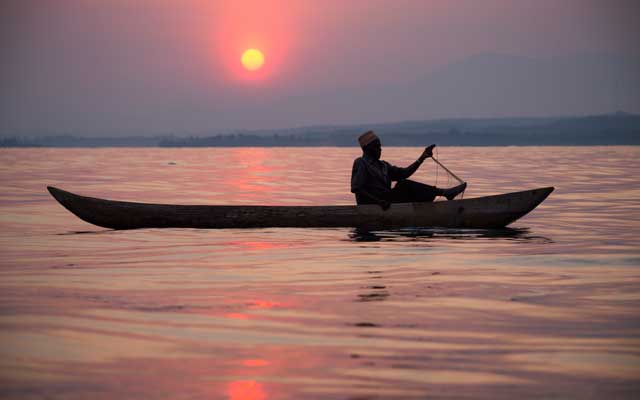 Tuungane Dugout, Lake Tanganykia. Photo courtesy of The Nature Conservancy
Tuungane Dugout, Lake Tanganykia. Photo courtesy of The Nature Conservancy
